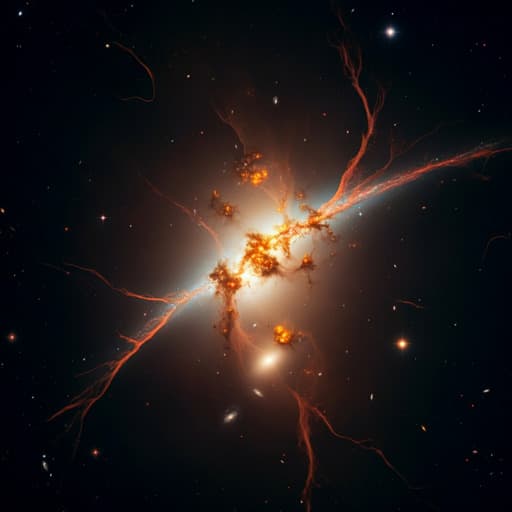
Physics
Identification of Superclusters and Their Properties in the Sloan Digital Sky Survey Using the WHL Cluster Catalog
S. Sankhyayan, J. Bagchi, et al.
This groundbreaking research by Shishir Sankhyayan and colleagues unveils a catalog of 662 superclusters, identified through a modified Friends of Friends algorithm. Spanning a vast redshift range and considerable sky area, these superclusters reveal fascinating insights into cosmic structure and evolution. Discover the profound correlations between supercluster density and their expansive reach in this intriguing study!
~3 min • Beginner • English
Introduction
The study investigates the identification and properties of superclusters—the largest coherent, massive structures in the cosmic web spanning tens to hundreds of Mpc. Superclusters affect galaxy and cluster evolution but lack a universally accepted definition. Prior definitions include (1) largest gravitationally bound overdensities that can collapse, (2) unbound overdense regions traced by matter/luminosity density fields, and (3) converging peculiar-velocity basins of attraction. While nearby systems like Laniakea can be identified via velocity flows, distant systems lack such data, necessitating alternative density-based or FoF methods. Superclusters are identified in literature via FoF on galaxy/cluster distributions, luminosity density thresholds, or watershed methods. Previous work suggests supercluster luminosity/mass increase with time while size decreases; environments within superclusters influence galaxy/cluster evolution. In ΛCDM, structure growth slows at z ≲ 0.5 due to dark energy, though overdense regions continue to grow; spherical collapse models predict thresholds for turnaround and collapse. The paper aims to build a statistically significant catalog of superclusters over wide redshift and sky coverage using WHL clusters, characterize their masses, sizes, density contrasts, and compare with cosmological simulations to understand dynamics (e.g., peculiar velocities) and environmental effects.
Literature Review
The authors situate their work within three supercluster definitions: gravitationally bound systems (e.g., Dünner 2006; Luparello 2011; Chon 2015), unbound overdensities via matter/luminosity fields (e.g., Einasto 2007a; Liivamägi 2012), and basins of attraction using peculiar velocities (e.g., Tully 2014; Pomarède 2015, 2020; Dupuy 2019). FoF and alternative methods (luminosity-density thresholds, watershed/Voronoi tessellation) have been used to extract superclusters. Observational studies show evolutionary trends in supercluster properties and environmental effects on galaxies/clusters (Einasto 2019, 2021; Lietzen 2012; Seth & Raychaudhury 2020; Alfaro 2022). Simulations and spherical collapse analyses suggest thresholds for boundness and future collapse (Einasto 2020, 2021c). Large well-known systems include Shapley, Corona Borealis, Sloan Great Wall, and Saraswati. Two comparable catalogs include Chow-Martínez et al. (2014; FoF on Abell/ACO clusters, z ≤ 0.15, all-sky excluding the Galactic disk) and Liivamägi et al. (2012; DR7 luminosity density, 0.02 ≤ z ≤ 0.5, smaller area). This work extends to wider sky (≈14,000 deg^2), 0.05 ≤ z ≤ 0.42, and provides mass estimates.
Methodology
Data: The WHL cluster catalog (Wen & Han 2015; updated WHL12) provides 85,686 groups/clusters within 0.05 ≤ z ≤ 0.42 over ≈14,000 deg^2. 89% of systems have spectroscopic redshifts (DR12), 11% photometric. Completeness exceeds 95% for M200c > 10^14 M⊙ in 0.05 ≤ z ≤ 0.42; false detection rate ≲ 6%. Richness-based mass proxies (R_L*,500) calibrated to X-ray/SZ are used, recognizing intrinsic scatter. To mitigate redshift-dependent incompleteness (especially low-mass clusters at higher z), the FoF linking length is weighted by selection functions rather than imposing a high mass cut.
Mock catalog: Halos are drawn from the Horizon Run 4 N-body simulation past lightcone (0 < z ≤ 0.4), displaced to redshift space by peculiar velocities. A HEALPix (Nside=64) sky mask matches WHL angular footprint; halos are selected in comoving distance bins to match WHL redshift and mass distributions, with minor adjustments for high-mass deficiencies by supplementing from adjacent lower-mass bins. To avoid redshift-space distortions near z≈0.4, mocks are limited to 0.05 ≤ z ≤ 0.366 for comparisons.
Modified Friends-of-Friends (mFoF):
- Neighbor identification uses 3D Delaunay triangulation to reduce distance computations from O(N^2) to O(N log N).
- Radial selection weights wr,i = φ/ϕ(z), where ϕ(z) is the observed number density and φ is the mean. The one-dimensional linking-length weight wf,i = [wr,i]^(1/3).
- Pairwise weighted linking length: l_ij = ((wf,i + wf,j)/2) × l0.
- Linking-length calibration: l0 chosen to maximize the number of candidate systems for minimum membership Nmin. To avoid percolation and spurious structures at large l0, Nmin=2 is adopted, yielding l0=20.65 Mpc for the full 0.05 ≤ z ≤ 0.42 sample. Superclusters in the final catalog are defined as candidate systems with ≥10 member clusters, ensuring total masses ≳10^15 M⊙.
Derived properties:
- Mass of each cluster: use WH15 richness–mass relation, log M500c = (1.08±0.02) log R_L*,500 − (1.37±0.02); then convert to M200c via R500c ≈ 0.65 R200c and spherical overdensity scaling; account for bound mass beyond virial radius with M_halo ≈ M_5.6c ≈ 2.2 × M200c. Supercluster total mass is the sum of member cluster bound halo masses.
- Size: maximum pairwise comoving separation among member clusters.
- Position: mass-weighted barycenter using M200c.
- Volume and density contrast: fit a 3D convex hull (Qhull) to member positions to estimate volume; density contrast δ = ρ_SC/ρ_m − 1 with ρ_m(z) = 3 H0^2 Ω_m (1+z)^3 / (8πG).
Robustness checks: The mFoF was also run on contiguous non-striped regions of the SDSS footprint; properties were consistent with the full-footprint results. Only 10/662 superclusters lie in striped regions.
Simulation analyses: Apply the same mFoF to mock WHL clusters (0.05 ≤ z ≤ 0.366). Examine correlations (δ vs size), membership distributions, and peculiar velocities. Stack phase-space diagrams of member halos relative to each supercluster center of mass to assess gravitational influence. Compute scaled radial profiles of peculiar velocity and number density versus r/rs (rs = size/2).
Key Findings
- Catalog: 662 superclusters identified from WHL clusters in 0.05 ≤ z ≤ 0.42; ≈12% of clusters (9,895) reside in superclusters. 183 superclusters (≈28%) include at least one Abell cluster. Median properties (full sample): mass ≈ 5.78×10^15 M⊙, size ≈ 64.9 Mpc, median density contrast ≈ 11.6, median member count = 13.
- Notable systems:
- Einasto Supercluster (new): z ≈ 0.25, mass ≈ 2.57×10^16 M⊙, size ≈ 111 Mpc, 54 members (includes Abell 1835, Abell 1801).
- Corona Borealis (rediscovery): SCl 2, z ≈ 0.08, 57 members, mass ≈ 2.55×10^16 M⊙, size ≈ 124 Mpc; combined with A2142 region by mFoF.
- Sloan Great Wall (rediscovery): represented by two superclusters SCl 3 and SCl 22 with differing morphologies.
- Saraswati (rediscovery): SCl 4 and SCl 231 together, 51 members, combined mass ≈ 2.6×10^16 M⊙, size ≈ 200 Mpc at z ≈ 0.28; Abell 2631 is the most massive cluster.
- Correlation: Density contrast versus size follows a power law: log δ = (−2.14 ± 0.07) log L + (4.95 ± 0.13), implying δ ∝ L^(−2.14). The trend arises from empirical M ∝ L^0.73 and V ∝ L^2.64 scalings.
- Environmental effect: Cluster masses in superclusters are slightly biased higher than in the field; KS test rejects identical distributions with p = 3.7×10^−52. Within superclusters, lower-mass systems (≲ 5×10^15 M⊙) tend to host lower-mass member clusters; median member mass increases mildly from ≈1×10^14 M⊙ to ≈1.8×10^14 M⊙ across the supercluster mass range.
- Observation–simulation comparison (restricted 0.05 ≤ z ≤ 0.366): Linking lengths that maximize candidates are 19.22 Mpc (WHL) and 19.88 Mpc (mocks). Size, density contrast, and membership distributions agree well; supercluster mass distribution in mocks is slightly lower due to a deficit of massive clusters in the HR4-based mock selection.
- Kinematics in mocks: Stacked phase space shows member halos predominantly have negative supercluster-centric radial peculiar velocities; fractions are ≈89% in “Supercluster Influence,” ≈2% “Hubble Decoupled,” and ≈9% “Outside Influence.” The mean radial peculiar velocity profile approaches zero at ≈4–5 rs, and the relative halo number density and velocity profiles show a characteristic scale near ≈1.5 rs, consistent with nonspherical supercluster shapes.
- Physical nature: All identified systems have δ > 0 and are better classified as unbound overdense regions (definition 2), expected to fragment into smaller structures rather than collapse wholesale, in line with examples like Saraswati and the BOSS Great Wall.
Discussion
The construction of a wide-area, intermediate-redshift supercluster catalog addresses the need for statistically significant samples to study large-scale structure evolution and environmental effects. The identified power-law relation between density contrast and size suggests underlying constraints from supercluster morphology and growth, potentially linked to the distribution and coupling of density waves at different scales. The mild but significant environmental bias in cluster masses indicates that residing in superclusters can enhance cluster growth, consistent with hierarchical structure formation and the accretion from surrounding voids/filaments. Comparisons with HR4-based mocks show broad agreement in structural properties, supporting the robustness of the mFoF method and selection-function corrections; remaining discrepancies in mass distributions are attributable to deficits of high-mass halos in the mock selection. Kinematic analyses demonstrate that most member halos are dynamically influenced by their host supercluster, slowing relative to the Hubble expansion within a characteristic radius, yet the overall systems are not fully bound in a spherical-collapse sense, aligning with the view of superclusters as unbound overdense regions that may fragment in the future.
Conclusion
The study presents a catalog of 662 superclusters identified in SDSS using a modified Friends-of-Friends algorithm that corrects for radial selection effects and leverages Delaunay triangulation. Typical masses exceed 10^15 M⊙ and sizes exceed 10 Mpc, with median mass ≈ 5.8×10^15 M⊙ and size ≈ 65 Mpc. A newly discovered massive system at z ≈ 0.25 (Einasto Supercluster) is reported. A strong power-law relation between density contrast and size (slope ≈ −2.14) is established. Evidence indicates that supercluster environments slightly bias cluster masses higher relative to the field. Mock comparisons demonstrate consistency in key structural metrics and reveal that most of a supercluster’s extent exerts gravitational influence on member halos, with characteristic scales in velocity and density profiles around ≈1.5 rs. Future work should refine mass estimates (including diffuse inter-cluster matter and richness–mass scatter), perform deeper spectroscopy of massive superclusters to assess dynamics and boundness, apply topological and morphological analyses to understand the δ–size relation, and exploit upcoming surveys (DESI, 4MOST, Euclid) to track supercluster abundance and properties to higher redshifts.
Limitations
- Mass estimates rely on richness–mass calibration with intrinsic scatter (not fully modeled); catalog is not volume-limited by mass.
- Inter-cluster diffuse matter is not included; total supercluster masses are likely underestimated (potentially by factors ≳2 in some cases).
- Selection-function corrections assume incompleteness independent of mass and adjust linking lengths accordingly; finer modeling of richness scatter and flux limits is deferred.
- Survey boundaries and redshift limits may truncate some superclusters near edges or at z bounds, underestimating sizes and memberships.
- Mock catalog shows a deficit of high-mass halos relative to observations, affecting mass distribution comparisons.
- Kinematic inferences are drawn from simulations; peculiar velocity data are not available for distant observed systems.
- Superclusters are nonspherical; using convex hulls and barycenters introduces geometry-dependent uncertainties in volume, density, and characteristic scales.
Related Publications
Explore these studies to deepen your understanding of the subject.







